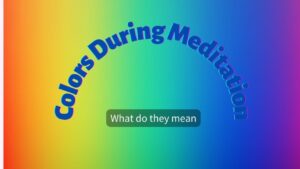The best Hz for meditation is a personal choice. Meditation to specific sound frequencies can take you up to a new level and raise your positive energy. Using meditation music to enhance your meditation practice is quite easy if you have the right resources to guide you.
Table of Contents
What Is Hertz Frequency?
The hertz is defined as one cycle per second. So 1 Hz is one cycle per second,
A frequency is defined as the number of occurrences per unit of time. It is more about speed and time.
It is a measure of how frequently an event occurs. When the frequency increases, it indicates that the occurrence occurs more frequently. The higher the frequency, the faster time passes between events; this is referred to as temporal frequency.
Hertz is simply the unit of measurement for frequency.
Everything has a frequency, however, hertz is typically used to measure things with several frequencies.
Hertz is most commonly used to describe musical and sound-related frequencies.
In terms of frequency, one Hertz is one full wave cycle per second.
For example, a sound wave’s frequency is 1 Hz if it completes one complete cycle in one second. The frequency of a sound wave is 10 Hz if it completes 10 cycles in one second.

The faster a wave moves, the higher its pitch. This means that different frequencies correspond to the pitch of various musical notes. The A note above Middle C, for example, has a frequency of 440 Hz.
“If you want to find the secrets of the universe, think in terms of energy, frequency, and vibration.” — Nikola Tesla
Which Music Frequency is Good for Meditation?
Music is one of the most powerful tools for meditation. It can help us get into a relaxed state, and it has a significant influence on our brainwaves. For example, to experience deep meditation, the hertz frequency should be at least 10 Hz.
There are two qualities of vibration that determine a sound: the amplitude, which is the magnitude of the vibration and determines how loud a sound is, and the frequency, which is the speed of the vibration and is measured in Hertz (Hz).
Some sound’s hertz frequency can enhance our vibrations and even alleviate anxiety and stress symptoms.
Solfeggio Frequencies and the Science Behind it

The solfeggio frequencies, often known as the seven tones of creation, have been used in religious and spiritual pursuits since ancient times.
But how exactly do they function? Some scholars believe that each tone correlates to a distinct chakra (or energy center) in our bodies.
By chanting or listening to these tones while meditating, you are effectively opening up and balancing the energy centers (chakras) of your body according to their respective frequency.
Are They Scientifically Supported?
While there is no definitive evidence that the Solfeggio tone would assist heal your body and mind after only one use, many people believe that listening to the solfeggio frequencies helps improve mental health.
The Benefits of 9 Hz Solfeggio Frequencies
Solfeggio frequencies provide a variety of physical and mental health benefits, including the ability to synchronize brain waves and induce a deep state of relaxation.
The main advantages of listening to Solfeggio Frequencies are reduced stress, fewer mood swings, lower blood pressure, and better sleep. Sound healing has also been used to cure a variety of medical and mental illnesses, including anxiety, sadness, PTSD, and even dementia.
The main Solfeggio frequencies range from 174 to 963 Hz.

Each of the nine Hz frequencies corresponds to a different chakra and is used to open the chakras and provide various mental and physical health benefits:
- 174 Hz – Pain and Stress Reduction
- 285 Hz – Tissue and Organ Healing
- 396 Hz – Liberating Guilt and Fear (Root Chakra)
- 417 Hz – Undoing Situations and Facilitating Change (Sacral Chakra)
- 528 Hz – Miracles and Transformation (Solar Plexus Chakra)
- 639 Hz – Making Connections (Heart Chakra)
- 741 Hz – Awakening Intuition (Throat Chakra)
- 852 Hz – Returning to Spiritual Order (Third Eye Chakra)
- 963 Hz – Enlightenment or Divine Consciousness (Crown Chakra)
What Are Binaural Beats Meditation? And the Magic of It?
Binaural beats are generally produced by playing slightly different frequencies separately into each ear through stereo headphones or speakers, which causes a third frequency to be heard as if it were beating within your head (which is also known as “brainwave entrainment”).
For example, if you hear 440 hertz (Hz) in your left ear and 442 Hz in your right ear at the same time, you will perceive 8 Hz as an audible beat between them!
They are produced by playing different tones separately into each ear through stereo headphones or speakers.
This third frequency can help to promote relaxation or focus, depending on which type of binaural beat you listen to.
This is because the binaural beats of a given Hz frequency can have distinct effects; for example, Alpha patterns between 7 and 13 hertz can help you relax, while Beta patterns between 13 and 30 hertz can boost alertness and reduce worry.
Delta waves with frequencies ranging from 0.5 to 4 Hz can promote deep sleep and ease insomnia, whereas gemma patterns can assist in maintaining arousal and reduce some symptoms of sadness.
What are the Best Hertz Frequencies to Use When Meditating?
The best hertz frequency for meditation is a personal choice. Some people believe that theta waves are the most effective, while others believe that the beta wave is the most beneficial.
The ideal hertz frequency for meditating or experiencing lucid dreaming is about 10-12 Hz.
There are many types of meditation frequencies from which to choose:
Alpha waves, which may be found in nature and in many creatures, are one of the most common.
Beta waves, which describe brain activity at rest or when concentrating on a single task, are another popular form of meditation frequency.
Delta waves, on the other hand, are slower than alpha and beta waves and are associated with deep sleep or unconsciousness.
How to Use Hertz Frequencies to Improve Your Meditation Practice
The human brain functions at roughly 60Hz, which is the same frequency as most electrical equipment. This indicates that your brain will be influenced when you are near technological devices.
The solution to this problem is to meditate using a well-known type of Hz frequency. Hertz frequencies can often assist you to achieve positive effects like going into deep relaxation in just a few minutes,
Some people utilize hertz frequencies with headphones, but others find earbuds or speakers to be more convenient because they allow for better concentration and less interference from other sources.
Not all hertz frequencies are created equal, so it’s important to do your research before investing in any device or product that promises to improve your meditation.
How to Choose the Best Hertz Frequency for Your Mindful Meditation
Take the time to listen to the audio files of the frequencies listed in this article. Discover your mind’s and body’s deeper or lighter response to each frequency.
Also, when deciding on the best Hz frequency for your mindful meditation, trust your gut.
Once you’ve found frequencies that work for you, the best thing to do is to stick with them and practice regularly! The more you meditate, the more benefits you’ll experience!
The sound vibrations of Earth’s electromagnetic field, deep space, and people in meditative states all resonate at a frequency of approximately 7.8 Hz (The frequency of Schumann resonance.)
Binaural beats in the theta (4–8 Hz) range are associated with REM sleep, reduced anxiety, relaxation, as well as meditative and creative states.
The use of Binaural beats at the alpha frequencies (8 to 13 Hz) is supposed to enhance relaxation and happiness, and decrease anxiety.
432 Hz is usually regarded as a superior tuning that improves the quality of music and has a favorable effect on the human mind and body.
There are also 639 Hz, 528 Hz, and 741 Hz frequencies, which may be beneficial for persons who are under stress.
Conclusion:
Meditation is about getting to know yourself, your subconscious mind, and learning to listen to your instincts.
There are many Hz frequencies that can be used during meditation to achieve different effects.
But how do you know if you’re meditating at the proper hertz frequency?
When you initially start out, try several Hz frequencies during a meditative state and find what works best for more positive energy.
Be patient, consistent, and enjoy the experimental process.
The goal is to always remain in the present moment and to connect with your deepest thoughts and feelings, no matter which Hz frequency you are trying!
Some people use Delta waves, which range from 0.5 to 4 Hz and are connected to deep sleep or the dream state. Others make use of Alpha waves, which have a frequency range of 8–12 Hz and are associated with relaxation or immediately before falling asleep.
Beta waves (12-30 Hz) are related to anxiety and stress reduction, whereas Gamma waves (30-100 Hz) are associated with peak mental function.
Some listen to Solfeggio frequencies, while others prefer using Binaural beats.
There is no one-size-fits-all answer when it comes to choosing the right meditation frequency. However, anyone can find a frequency that works for them with a little trial and error.
You will find what works for you.
Resources
If you’re looking for some great options when it comes to meditation music, here are a few of our favorites:
- Calm.com
This website offers a variety of binaural beats and isochronic tones that can be used for meditation, relaxation, and focus. A great thing about Calm.com is that they offer a free trial, so you can try out their service before committing to a paid subscription!
- Headspace.com
Headspace is a popular meditation app that offers a 10-day trial so you can try out the content and see if it’s a good fit for you. They have a variety of guided meditation programs as well as binaural beats and isochronic tones that can be used for both relaxation and focus.
- Brain.fm
Brain.fm is a website that offers brainwave entrainment music for a variety of different purposes, including meditation, relaxation, sleep, and focus. They have a free trial, so you can try out their service and see if it’s right for you!
- meditationoasis.com
This website offers a variety of guided meditation programs as well as binaural beats and isochronic tones. You’ll find a mix of free and paid content on Meditation Oasis, so there’s something for everyone!
These four resources should be enough to get you started.










